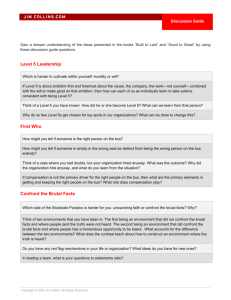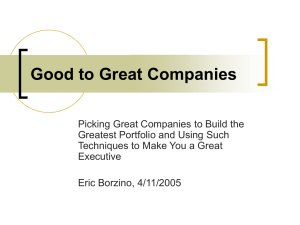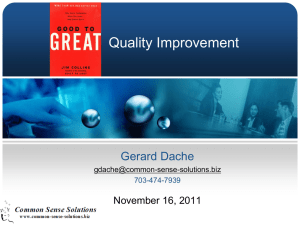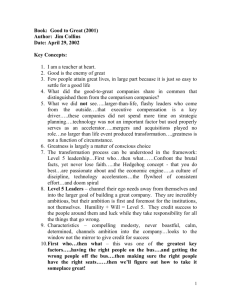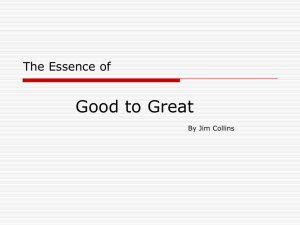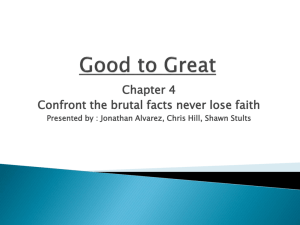Good to Great
advertisement
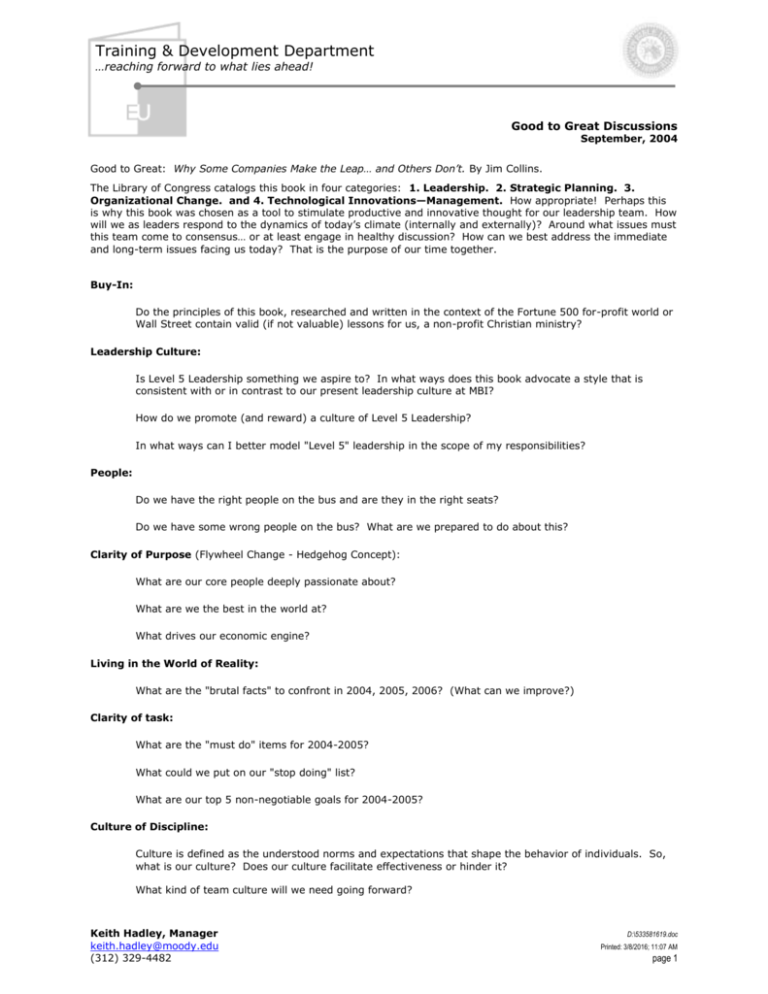
Training & Development Department …reaching forward to what lies ahead! Good to Great Discussions September, 2004 Good to Great: Why Some Companies Make the Leap… and Others Don’t. By Jim Collins. The Library of Congress catalogs this book in four categories: 1. Leadership. 2. Strategic Planning. 3. Organizational Change. and 4. Technological Innovations—Management. How appropriate! Perhaps this is why this book was chosen as a tool to stimulate productive and innovative thought for our leadership team. How will we as leaders respond to the dynamics of today’s climate (internally and externally)? Around what issues must this team come to consensus… or at least engage in healthy discussion? How can we best address the immediate and long-term issues facing us today? That is the purpose of our time together. Buy-In: Do the principles of this book, researched and written in the context of the Fortune 500 for-profit world or Wall Street contain valid (if not valuable) lessons for us, a non-profit Christian ministry? Leadership Culture: Is Level 5 Leadership something we aspire to? In what ways does this book advocate a style that is consistent with or in contrast to our present leadership culture at MBI? How do we promote (and reward) a culture of Level 5 Leadership? In what ways can I better model "Level 5" leadership in the scope of my responsibilities? People: Do we have the right people on the bus and are they in the right seats? Do we have some wrong people on the bus? What are we prepared to do about this? Clarity of Purpose (Flywheel Change - Hedgehog Concept): What are our core people deeply passionate about? What are we the best in the world at? What drives our economic engine? Living in the World of Reality: What are the "brutal facts" to confront in 2004, 2005, 2006? (What can we improve?) Clarity of task: What are the "must do" items for 2004-2005? What could we put on our "stop doing" list? What are our top 5 non-negotiable goals for 2004-2005? Culture of Discipline: Culture is defined as the understood norms and expectations that shape the behavior of individuals. So, what is our culture? Does our culture facilitate effectiveness or hinder it? What kind of team culture will we need going forward? Keith Hadley, Manager keith.hadley@moody.edu (312) 329-4482 D:\533581619.doc Printed: 3/8/2016; 11:07 AM page 1 Training & Development Department …reaching forward to what lies ahead! Good to Great – Themes from the Book Moving from “Good to Great1” (Summary by Wayne P. from a similar challenge issued to WMBI) 1. Level 5 Leadership: Self-effacing, quiet, reserved; blend of personal humility and professional will. Ambition for the company more than for personal success; wants to see company even more successful in the next generation. 2. First who…then what: get the right people on the bus. Get the wrong people off the bus and the right people in the right seats. Then figure out where to drive it. Letting the wrong people hang around is unfair to the right people. Put your best people on the biggest opportunities. 3. Confront the brutal facts (yet never lose faith). Confront the must brutal facts. At the same time, maintain unwavering faith that you will prevail in the end, regardless of difficulties. If a charismatic leader is defining force, it can be a liability. Lead with questions, not answers. Fix problems without fixing blame. 4. The Hedgehog Concept: Those who make the biggest impact took a complex world and simplified it. The essence of profound insight is simplicity. They attained a very simple concept that they used as a frame of reference for all their decisions, and this understanding coincided with breakthrough results. 5. Three Circles: What can you be the best in the world at? The distinction of what you can be the best at is absolutely crucial. Find what you’re best at and stick to it. Focusing on what you do better than any one else is the key to greatness. What can you NOT be the best in the world at? If we’re not the best at it, why are we doing it? What drives your economic engines? Deep understanding of the economic engine What are you deeply passionate about? We should only do those things we’re passionate about. 6. A culture of discipline A bureaucracy is to compensate for incompetence—a problem that goes away if you have the right people in the first place. Most companies build bureaucracy because of a few wrong people on the bus. Build a culture around Freedom within a framework a. Fill that culture with self-disciplined people willing to go the distance. b. Adhere with consistency to the Hedgehog Concept. Have a ”stop doing” list? 1 Good to Great: Why Some Companies Make the Leap and Others Don’t by Jim Collins, HarperBusiness, New York, 2001. Keith Hadley, Manager keith.hadley@moody.edu (312) 329-4482 D:\533581619.doc Printed: 3/8/2016; 11:07 AM page 2


